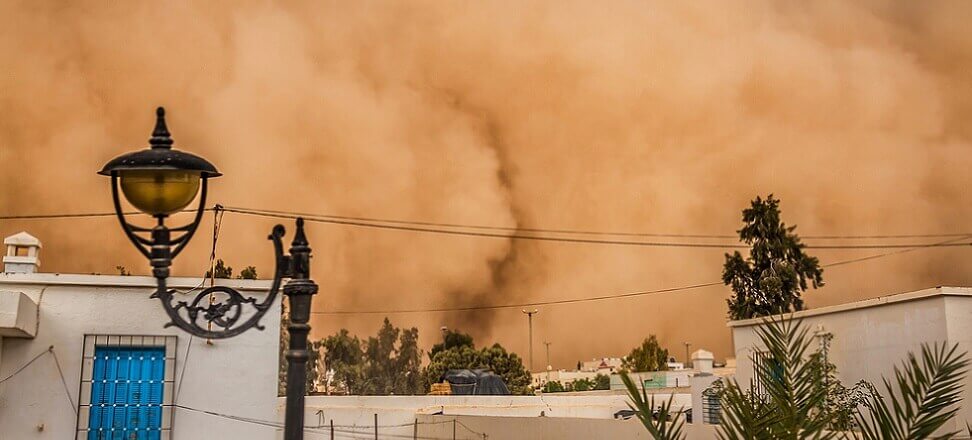Strangely hazy skies, colorful sunsets and a thin layer of fine sand covering everything is nothing more than dust from the Sahara coming over Europe. Reports of this phenomenon seem to have been in the media with increasing frequency in recent years. There is speculation about the true source of the dust and its harmfulness, and questions about whether climate change has affected the frequency and intensity of the phenomenon. While science knows the answer to the speculation, the link to climatic conditions remains unexplained.
Long-distance dust transport is one of the natural processes occurring around the world and one of the key variables affecting weather, climate and air quality. The Sahara is the main source of atmospheric dust in Africa and Europe, and dust from the Gobi even reaches as far away as Hawaii. The main reason is the wind.
Changing climate an ambiguous culprit
Starting in 2020. There have been several extremely significant episodes of Saharan dust transport. In February, a huge cloud covered the Canary Islands, paralyzing traffic and air traffic. Another large shipment reached the Caribbean and the Gulf of Mexico in June. It was triggered by intense sandstorms that raged in Niger, Mali and Chad. A dust transport in February 2021 caused exceptional effects, staining the snow cover in the Alps orange. In turn, in March 2022. Dust from over the Sahara has reached as far as Scandinavia, and concentration records have been broken in Spain.
Research to date does not confirm a clear and distinct trend of change. Of course, droughts and desertification caused by global warming can promote the expansion of dust source areas – as can improper water and land use. A look into the past shows that the phenomenon of desert dust transport to Europe has been occurring for thousands of years and is characterized by periodic variability.
In one 2019 publication. scientists presented the results of ice cores taken in the Alps [1]. Exceptionally high dust content was recorded for the 870-100s, a period when the northern part of the globe was warmer than the rest of the world. Similar events have been reported for the years 140-170, 370-450 or 1320-1370. In turn, in 2022. Spanish researchers have argued that the frequency and intensity of dust transport episodes in the western Mediterranean has increased since the middle of the last century [2].
Unusual intensity of the phenomenon in late 2023 and early 2024. caused the world to pay attention to them again. So far, winter has been considered the season with the lowest dust transport activity in Europe and the Mediterranean. According to scientists, the higher frequency of dust episodes is a result of the persistent drought in the Maghreb, the increase in Mediterranean surface temperatures, and changes in air circulation in the region.
A team of researchers from Hungary and Romania, who studied, among other things, came to similar conclusions. sediments deposited in Lake Balaton [3]. They presented evidence of changes in air circulation patterns that led to an increase in the frequency and intensity of dust events in the Carpathian Basin. Between 1979 and 2010, the annual number of such episodes averaged 4.2, while between 2011 and 2018 it was 10.3.
Is Sahara dust harmful to health?
It all depends on the concentration of particles in the air and the height at which they travel. While transport in the upper layers of the atmosphere will not affect humans, cloud travel closer to the surface worsens air quality and can be dangerous to the respiratory and cardiovascular systems. Therefore, follow reports from local air quality assessment institutions and when dust concentrations are high, avoid staying outdoors for long periods of time and limit physical activity.
Saharan dust also carries microorganisms, including pathogens. In samples collected between 2013 and 2016 in Senegal, researchers detected the presence of microorganisms that can affect ecosystems and public health [4]. At present, however, there is no evidence of infectious diseases in humans caused by pathogens transported long distances during dust episodes.
Everything that flies must eventually fall
For years, mineral dust has been treated neglectfully by researchers. Today we know that they are one of the key factors affecting the planet’s atmosphere, weather and climate. On the one hand, the dust reduces the inflow of solar radiation to the Earth’s surface, contributing to lower temperatures; on the other hand, the absorption of radiation by a layer of darker dust can lead to local warming. Traveling great distances, Saharan dust carries nutrients such as phosphorus, iron and organic matter and accelerates phytoplankton blooms. It also has a catastrophic effect on snow and ice cover, causing faster melting and further increases in temperature. Very high concentrations of dust in the air reduce visibility, damage mechanical equipment and reduce the efficiency of photovoltaic panels.
But can sand from the Sahara change rainfall patterns?
A team from the University of California came to some extremely interesting conclusions [5]. In 2013. they argued that the amount of rain and snowfall in the Sierra Nevada mountains depends on dust transport. During winter storms (2009-2011), they collected precipitation samples, determined their chemical composition, and then combined them with satellite data to provide a picture of the complex processes that cause winter precipitation in California.
Prather and her colleagues discovered tiny particles of dust and bacteria in the snowpack from deserts thousands of kilometers away from the US west coast. And they noticed a clear correlation – the greater the snowfall, the more dust was found in the samples. It is well known that pollution particles are nuclei of condensation around which clouds and rain (or snow) form. According to U.S. researchers, dust and bacteria brought by the wind aid this process because they condense moisture exceptionally well.
Under the watchful eye of experts
Monitoring dust episodes and forecasting concentrations and directions of dust transport are made possible by satellite, aerial and ground observations. Satellites are able to detect the presence of fine and coarse pollutant particles in the vertical column of the atmosphere due to the optical properties of aerosols. Moreover, modern apparatus is able to distinguish desert dust from other atmospheric aerosols. Data on this subject are collected by the Copernicus Atmosphere Monitoring Service (CAMS) and are used to model the development of dust phenomena and prepare possible scenarios for their development. Global atmospheric composition forecasts for the next 5 days are updated every 12 hours. The air quality forecast for Europe, on the other hand, is published once a day for the next four days. All CAMS forecasts, analysis and data are available free of charge.
The transport of minerals and microorganisms contained in desert dust appears to be an important element in shaping atmospheric, hydrological and climatic conditions worldwide. However, whether these are negative or positive consequences has not yet been studied.
Rafal Stepnowski, UW graduate, geographer, hydrologist, popularizer of Earth sciences. Specialist in the field. communications and content marketing.
In the article, I used, among other things. From the works:
[1] Clifford H. M., Spaulding N. E., Kurbatov A. V., et al. (2019). A 2000 year Saharan dust event proxy record from an ice core in the European Alps. Journal of Geophysical Research:Atmospheres,124, 12,882-12,900. https://doi.org/10.1029/2019JD030725
[2] Salvador P., Pey J., Pérez N. et al. (2022). Increasing atmospheric dust transport toward the western Mediterranean over 1948-2020. npj Clim Atmos Sci 5, 34 (2022). https://doi.org/10.1038/s41612-022-00256-4
[3] Rostási Á, Topa B. A., Gresina F., et al. (2022). Saharan Dust Deposition in Central Europe in 2016-A Representative Year of the Increased North African Dust Removal Over the Last Decade. Front. Earth Sci. 10:869902. doi: 10.3389/feart.2022.869902
[4] Marone, A., Kane, C. T., Mbengue, et al. (2020).Characterization of Bacteria on aerosolsfrom dust events in Dakar, Senegal,West Africa.GeoHealth,4,e2019GH000216. https://doi.org/10.1029/2019GH000216
[5] Creamean J. M., Suscki K.J., Rosenfeld D., et al. (2013). Dust and Biological Aerosols from the Sahara and Asia Influence Precipitation in the Western U.S. Science 339,1572-1578. DOI: 10.1126/science.1227279
[6] A 2000 year Saharan dust event proxy record from an ice core in the European Alps
[7] Increasing atmospheric dust transport towards the western Mediterranean over 1948-2020
[10] Characterization of bacteria on aerosols from dust events in Dakar, Senegal, West Africa
[11] Dust and biological aerosols from the Sahara and Asia influence precipitation in the Western U.S..

 Polski
Polski






